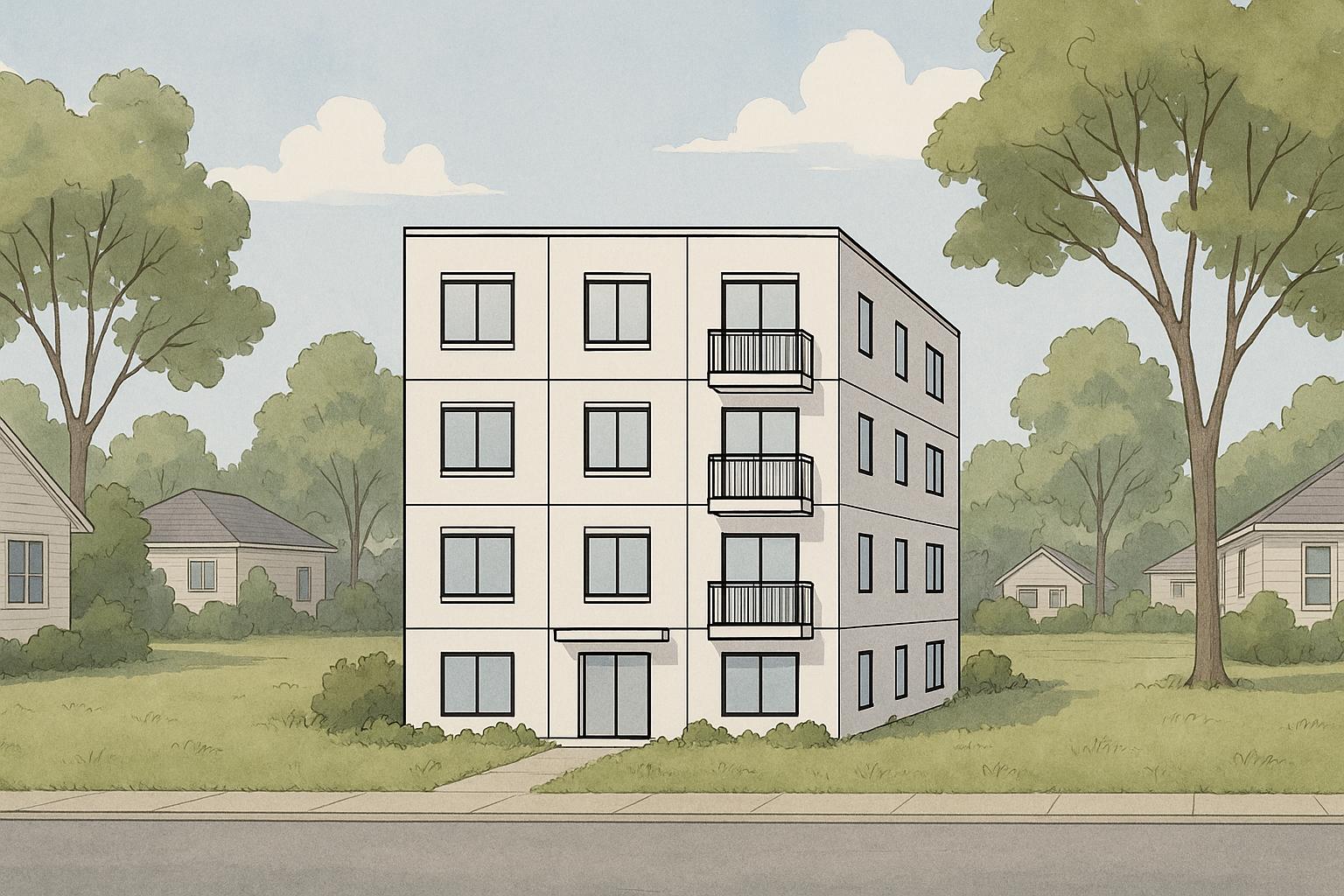Reducing neighbourhood opposition to a 4‑plex in Nova Scotia requires early engagement, clear communication, and careful planning. The key is to address common concerns like parking, noise, and neighbourhood character before they escalate into formal complaints. Here's how to navigate the process:
- Start Early: Host informal meetings with neighbours before submitting plans to build trust and transparency.
- Focus on Key Stakeholders: Engage immediate neighbours, community leaders, and municipal councillors to address concerns directly.
- Use Pre-Approved Designs: Streamline approvals by aligning with zoning rules and using federally approved templates.
- Manage Construction Impacts: Assign a liaison, minimize disruptions, and ensure quality control with independent inspections and fixed timelines.
- Highlight Benefits: Show how the project supports local housing needs and benefits the community.
Can Ontario Cities Overcome NIMBYism? | The Agenda
Community Engagement Tactics That Work
Getting ahead of potential "Not In My Backyard" (NIMBY) resistance is crucial when planning a 4‑plex project. In Nova Scotia, early and thoughtful engagement with neighbours can help avoid unnecessary delays and smooth the approval process.
Start Early with Clear Communication
One of the biggest missteps developers make is waiting until after submitting plans to start conversations with neighbours. By then, residents may feel blindsided, which often leads to resistance.
A better approach? Host an informal neighbourhood meeting at least two months before submitting your application. Keep the tone casual - consider hosting it at your home or a local community centre. Share straightforward plans, like simple architectural sketches showing what the building will look like from the street. Address common concerns such as parking, construction timelines, and how the project fits into the neighbourhood.
For those who can’t attend in person, offer virtual options like Zoom presentations. Record these sessions so neighbours can revisit the details later.
The aim here isn’t to win over every single neighbour. Instead, it’s about showing that you’re open and approachable. When people feel informed and included early on, they’re much less likely to oppose your project during formal municipal hearings.
Identify Key Stakeholders
Once you’ve started communicating, it’s important to identify the individuals and groups that hold sway in your community.
Begin with your immediate neighbours - the ones living right next to your lot - since they’ll be the most directly impacted. Then, expand your focus to include local influencers. These might be community association leaders or residents who are regularly involved in municipal meetings. For instance, in Halifax Regional Municipality, association heads often have strong connections with councillors. In smaller communities like Wolfville or Antigonish, long-time residents active in local politics can significantly influence public opinion.
It’s also wise to meet with your municipal councillor early on. Introduce your project and discuss any concerns they foresee. This step not only helps you address potential issues but also shows that you’re taking a collaborative approach.
Tailor your messaging to the priorities of each group. Immediate neighbours are likely most concerned about noise, parking, and construction disruptions. Community leaders might focus on neighbourhood character and planning goals. Councillors, on the other hand, will want assurance that your project aligns with zoning regulations and includes thorough community consultation.
Use Success Stories to Build Credibility
Sharing real-life examples of similar projects can go a long way in easing concerns. Highlight successful 4‑plex developments in Nova Scotia, such as those in Halifax’s south end or Dartmouth. If possible, organize a short tour to show neighbours how these projects have been integrated into their communities.
Another effective strategy is to emphasize the economic benefits. A 4‑plex brings new residents who will shop at local businesses, use community services, and contribute to the neighbourhood’s vibrancy. In smaller towns, this added activity can provide a meaningful boost to local shops and services.
By showcasing proven examples and clearly outlining the benefits, you can shift the conversation. Instead of focusing on why the project shouldn’t happen, neighbours may start thinking about how it can work for everyone.
When neighbours feel informed and engaged, you’re in a much stronger position to secure municipal approval and manage construction impacts. Early, honest communication builds trust and helps pave the way for smoother approvals down the line.
Communication Templates You Can Use
Here are some ready-to-use templates to help you communicate effectively about your 4‑plex project. These templates are designed to support clear and concise messaging with neighbours and municipal officials, ensuring transparency and fostering positive relationships.
Neighbour Introduction Letter
This introduction letter helps build good rapport with your neighbours by addressing potential concerns in a friendly and approachable manner.
Subject: Introduction – Upcoming 4‑Plex Development at [Your Address]
Dear Neighbour,
My name is [Your Name], and I’m reaching out to inform you about my upcoming 4‑plex project at [Property Address]. As a member of this community, I believe it’s important to keep everyone informed about developments that may impact our neighbourhood.
Project Overview:
I’m planning to construct a 4‑plex that will provide much-needed rental housing for families in our area. The design has been thoughtfully created to fit the character of our neighbourhood and includes [number] designated parking spaces for residents.
Timeline:
Construction is set to begin in [Month Year] and is expected to wrap up by [Month Year]. Work will take place between 7:00 AM and 6:00 PM on weekdays, with minimal work on Saturdays.
What to Expect:
While there may be some temporary disruptions during construction, I’ll do my best to keep them to a minimum.
Our Commitment:
I’m committed to addressing any concerns that may arise and ensuring the project progresses with as little inconvenience as possible.
Community Benefits:
This project will help address Nova Scotia’s housing challenges by adding new rental options for families. It will also bring new residents who will support our local businesses and services, contributing to the long-term growth of our community.
If you have any questions or concerns, please don’t hesitate to contact me at [phone number] or [email address]. Additionally, I’m hosting a short neighbourhood meeting on [date] at [time] and [location] to share the project plans in person.
Thank you for your understanding and support.
Sincerely,
[Your Name]
[Your Contact Information]
Municipal Submission Cover Letter
This cover letter template ensures your development application is professional and aligns with local housing priorities while showing your commitment to compliance and community engagement.
[Date]
Planning and Development Department
[Municipality Name]
[Address]
Re: Development Application – 4‑Plex at [Property Address]
Dear Planning Staff,
I am pleased to submit this application for a 4‑plex development at [Property Address]. This project aligns with Nova Scotia’s housing goals and directly addresses the housing shortage identified in Halifax Regional Municipality. It also contributes to the province’s target of 68,841 new housing units under the Action for Housing plan.
Community Engagement:
This application reflects input gathered during neighbour engagement sessions and adheres to municipal guidelines. I’ve communicated with nearby residents through letters and meetings, and the feedback has been largely positive. Most questions have focused on construction timelines and parking, both of which are addressed in the attached plans.
Growth Area Alignment:
[If applicable] The proposed site falls within a designated growth area, supporting municipal goals for intensification while preserving the neighbourhood’s character.
The attached documents highlight my commitment to delivering high-quality housing that enhances our community. I’m available to discuss any aspect of this application and look forward to working with your team throughout the approval process.
Thank you for your time and consideration.
Sincerely,
[Your Name]
[Title]
[Contact Information]
sbb-itb-16b8a48
Municipal Approvals and Zoning Requirements
Getting through the municipal approval process smoothly can help reduce opposition from those with a "Not In My Backyard" (NIMBY) mindset. By meeting regulatory standards early on, you can limit valid objections, create a solid groundwork for future approvals, and foster trust within the community.
Zoning and Bylaw Compliance Checklist
Before submitting your application, double-check that your property and proposed fourplex comply with local zoning and building codes. Here's a handy checklist to guide you:
- Zoning Verification: Confirm that your property is zoned for multi-unit residential use in your municipality.
- Setback Requirements: Ensure your site plan adheres to local setback regulations.
- Parking Standards: Verify that you meet the required number of parking spaces per unit.
- Lot Coverage and Floor Area Ratio: Check that your building design stays within municipal limits for lot coverage and floor area ratio.
- Height Restrictions: Make sure your proposed building doesn't exceed local height limits.
- Landscaping and Green Space: Include any required green spaces or landscaping features in your plans.
For exact details, reach out to your local planning department.
Use Pre-Approved Designs
Once you've confirmed compliance, consider using standardized designs to make the approval process easier. The federal Housing Design Catalogue, introduced in March 2025, provides pre-approved fourplex designs with several benefits:
- Approval Advantages: These designs align with established building codes, making it easier for municipal planners to review and approve your project.
- Cost Predictability: Each design comes with a construction cost summary, helping you present clear budget details to municipal staff and the community.
- Quality Assurance: Architectural and engineering packages from Spring 2025 ensure high construction standards.
- Funding Alignment: If you're applying for federal programs like the Canada Housing Infrastructure Fund, using these designs may be a requirement.
Integrated Design-Build Approach
Pairing [pre-approved designs](https://heliourbandevelopment.com/per Простs-4-plex-nova-scotia-checklist-fees-lead-times) with an integrated design-build strategy can further streamline the process and build trust. This approach consolidates design, engineering, and construction under one team, offering several key advantages:
- Single Point of Contact: A unified team ensures consistent communication with municipal officials, reducing confusion and miscommunication.
- Efficient Problem Resolution: When issues arise, the team can quickly coordinate and address them, keeping the process on track.
- Enhanced Credibility: A professional, cohesive approach reassures municipal staff and local residents that your project is in capable hands.
- Complete Documentation: Coordinated submission packages that meet all municipal requirements help avoid unnecessary back-and-forth, reinforcing confidence in your project's management.
Reducing Construction Impacts and Building Trust
Once municipal approvals are in place, the real test of community trust begins on the construction site. While some disruption is inevitable, taking proactive steps can help reduce its impact on neighbours. A well-managed project can leave a positive impression, while a chaotic one can lead to lasting resentment.
Minimizing Disruption During Construction
Start by assigning a neighbour liaison from your construction team. This person should introduce themselves to nearby residents on the first day, share their contact information, and provide weekly updates about upcoming construction activities. This keeps communication open and helps resolve issues quickly.
Control dust and debris by using temporary fencing and dust suppression measures, especially during dry weather. Ensuring materials stay contained within the site is another simple but effective way to maintain order.
Manage parking and traffic flow carefully to avoid inconveniencing neighbours. Construction vehicles shouldn’t block driveways or take up street parking that locals rely on. Set up designated areas for worker parking and deliveries, and make sure these arrangements are clear to everyone involved.
A smooth construction phase lays the groundwork for the next critical step: maintaining rigorous quality control.
Fixed-Price Contracts and Timeline Guarantees
Nothing frustrates neighbours more than a project that drags on indefinitely. A six-month build that stretches far beyond its timeline can turn initial supporters into vocal critics.
Using fixed-price contracts can help avoid the financial pressures that sometimes lead to delays or shortcuts. On the other hand, cost-plus contracts can create uncertainty and even incentivize delays, fuelling opposition from neighbours who feel left in the dark.
The traditional approach, where property owners juggle separate contracts for design, engineering, and construction, often leads to finger-pointing when delays occur. This lack of coordination can make the project appear unprofessional to the community.
By offering guaranteed timelines with financial penalties, contractors show they’re serious about delivering on their promises. For example, a six-month timeline with penalties of $1,000 per day for delays provides neighbours with a clear endpoint and builds confidence. This approach stands in sharp contrast to the "wait and see" attitude common in smaller projects, where timelines often balloon to 12–18 months.
Quality Control with Third-Party Inspections
Strong quality control measures can ease concerns about how a project might affect property values or the neighbourhood’s character. When neighbours see a commitment to high standards, their fears may start to fade.
Independent engineering inspections throughout the construction process show that quality is a priority, not just meeting the bare minimum required by municipal codes.
Allowing property owners to select their own inspector for the final quality check adds another layer of transparency. This demonstrates confidence in the work and creates a documented record of the project’s quality.
Offering extended warranties - such as a two-year guarantee on all construction work - further reassures both neighbours and property owners. It shows a commitment to addressing any issues that might arise after completion.
Finally, daily photo documentation can provide a clear, visual record of progress. This not only keeps the project team accountable but also reassures neighbours that the work is being done in an organized and professional manner.
Conclusion: Building Success with Community Support
Creating a successful 4‑plex project in Nova Scotia hinges on blending municipal compliance with genuine community collaboration. Together, these approaches can transform resistance into support.
Starting with early engagement and maintaining open communication throughout the process helps address concerns head-on and keeps everyone in the loop. Meeting regulatory requirements with pre-approved designs and using integrated design‑build teams shows professionalism while avoiding coordination issues that could erode trust.
During construction, trust is either built or lost. Managing disruptions carefully and keeping neighbours informed can make all the difference. Fixed‑price contracts with clear timeline guarantees reassure the community, while quality control measures, such as independent inspections and extended warranties, demonstrate your commitment to enhancing the neighbourhood. These efforts not only ensure a smooth project but also establish a strong reputation that can lead to future opportunities.
Earning community support is about building lasting relationships that benefit everyone involved. A well-managed 4‑plex project reflects responsible practices and positions you as a dependable builder. When neighbours see you keep your promises, they’re more likely to back future housing projects, creating long-term value that goes far beyond a single development.
FAQs
How can I proactively address NIMBY concerns when planning to build a 4-plex in Nova Scotia?
To keep NIMBY concerns from growing into larger issues, it’s important to start with open and honest communication with your neighbours as early as possible in the planning process. Share your plans for the project, and take the time to explain how it could benefit the community, like creating more housing options.
Anticipate possible concerns by providing straightforward, clear details about your 4-plex’s design, its potential impact, and the advantages it offers. You might even want to prepare templates to address common questions or objections in a thoughtful and respectful way. Hosting community meetings or having casual conversations with your neighbours can go a long way in building trust and easing resistance.
How do pre-approved designs and a design-build approach make it easier to get a 4-plex approved in Nova Scotia?
Pre-approved designs and a combined design-build approach can make the approval process for a 4-plex in Nova Scotia much smoother. Using standardized designs, like those found in the Housing Design Catalogue, ensures that plans already meet building code requirements. This can cut down on compliance checks and eliminate the need for costly revisions, helping you move your project forward faster.
The design-build method takes it a step further by merging the design and construction phases under one team. This approach simplifies communication, reduces delays in municipal approvals, and creates a more straightforward path to completing your project. By using these strategies, you can save time, reduce expenses, and increase the likelihood of gaining support from both the community and local authorities.
How can I reduce disruptions and build trust with neighbours during fourplex construction?
Keeping disruptions to a minimum and maintaining good relationships with neighbours is key when undertaking a fourplex construction project. Start by sharing the project timeline well in advance, along with details about any potential inconveniences like increased noise or traffic. Regular updates throughout the process can help avoid confusion and keep everyone informed.
Partnering with experienced local contractors can make a big difference. Contractors familiar with the area are often better equipped to manage the project efficiently, helping to prevent unnecessary delays. Choosing materials that are both cost-effective and environmentally conscious can also reflect a commitment to responsible construction, which neighbours are likely to appreciate.
Lastly, take concerns seriously and address them promptly. Being approachable and open to feedback shows a genuine willingness to work with the community, which can help build trust and maintain positive relationships throughout the construction process.
Related Blog Posts
- How Public Input Shapes Zoning Approvals in Nova Scotia
- Small Multi-Unit Development 101: Building Duplexes and Fourplexes in Nova Scotia
- Neighbor‑Friendly Design Moves Under HR‑1: Stepbacks, Entries, and Materials That Calm Concerns
- Permits for a 4‑Plex in Nova Scotia: The Complete Checklist with Fees and Lead Times



